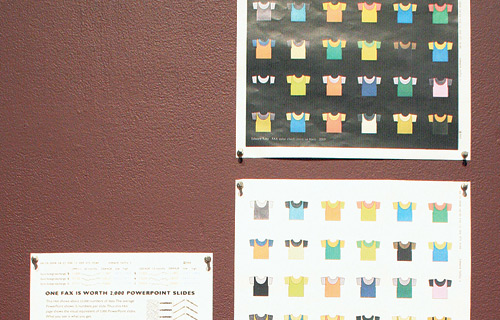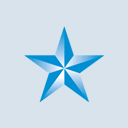Gallery at UH getting a ‘FAX’

Although sent by fax, works by Hugo Crosthwaite show remarkable definition.

Edward Tufte, professor of political science, computer science and statistics, submitted a variety of work for "FAX," showing at University of Hawaii Art Gallery.


Anyone who’s heard "Purrrrrr-SCREEEECH!" over the phone knows how annoying it can be to dial up a fax machine.
An exhibit at the University of Hawaii-Manoa Art Gallery, however, presents the technology as an art medium, a method of creating and transferring art and its message around the world. The traveling show, "FAX," displays documents printed on a fax machine, which lies awaiting the artists’ call in a corner of the gallery.
UH art department faculty and staff have selected a group of contributors with connections to Hawaii to fax in works over the next several weeks. Visitors can expect a diverse range of topics, with the group comprising not only traditional artists, but also architects and photographers.
‘FAX’» Where: University of Hawaii Art Gallery » When: Through April 5, 10:30 a.m. to 5 p.m. Mondays to Fridays and noon to 5 p.m. Sundays (closed March 26 to 30 for spring break) » Info: 956-6888 or visit www.hawaii.edu/art/exhibitions/art_gallery Opens in a new tab Don't miss out on what's happening!Stay in touch with breaking news, as it happens, conveniently in your email inbox. It's FREE!
By clicking to sign up, you agree to Star-Advertiser's and Google's Terms of Service Opens in a new tab and Privacy Policy Opens in a new tab. This form is protected by reCAPTCHA.
» Also: Free lecture about the exhibit by curator Joao Ribas, 6 p.m. March 19 at the UH Art Auditorium
|
"The whole show is sort of like ‘a happening,’" said one of the contributors, Kloe Kang, an artist known for her whimsical, observational still-lifes. "It’s not just a traditional show, but it will continue changing and happening."
Kang said the project has her thinking about the communications and transportation aspects implied in fax technology, with her thoughts ranging from childhood visits to a newspaper and seeing news come over the wire, "teletransportation" technologies in science-fiction novels and movies and her own past as an immigrant from Korea. She has not yet created her piece for the show.
"There are a lot of open ends to this project," she said. "That’s the fun part of the project, too."
"FAX" originated three years ago in New York and has traveled to several locations, growing along the way. Of the works already on display, it is apparent that some artists used fax technology as a kind of print technology. Drawings by Hugo Crosthwaite, a Mexican-born artist, use the sharp contrasts of fax printing to create images that appear almost etched.
But others played on the technology itself. Olav Westphalen’s "Five Pages of Possibility Infinite Proportions: Smoke Signals," will ring alarmingly true to anyone who’s seen their paper supply exhausted by a seemingly endless fax transmission. He made a rudimentary drawing of a fire with smoke billowing out, then more panels showing a trail of smoke. The sender is instructed to make a loop out of the smoke panels and feed it continuously into the fax machine, creating a fire "with endless smoke, until the machine runs out of paper, or catches fire."
Gordon Sasaki, who studied at UH and now lives in New York, sees the show as an opportunity to expand his work that "focuses on the body." Injured in a car accident in 1982, he now uses a wheelchair and has been involved in access issues.
Sasaki will be faxing in close-up photographs of different parts of his face — eyes, nose, mouth, forehead — all on different sheets. "All the photos were taken at the same time of separate days, but I just did that because I wanted different looks," he said. "It gives you options in assembling it in different ways."
Another local contributor, Dorothy Faison, is using the project to supplement her existing project, "the Lawnboat Historical Society," a fictional organization dedicated to ships that transported grass lawns around the world. Her sophisticated website, lawnboats.com, comes complete with video, links to historical references, membership information and store. It details in deadpan humor how ships piled with grass lawns traversed the world, eventually centering on the "Sandalwood Islands."
Her contribution will include a series of transmissions involving the trade of lawn for sandalwood, a representation of how faxing was used "to send bills of lading and so forth."
The instantaneous communicative aspects of fax technology are what appealed to another contributor, Bundit Kanisthakhon. He will fax in whatever inspires him on his deadline days for the exhibit, March 15-17. "People tend to plan ahead of time so much, and things become too sterilized," he said. "So what I’m trying to do is not think about it too much and just go with the flow at that time and at that place."
João Ribas, who originally curated the exhibit for the Drawing Center in New York, said the project started as "an attempt to think of drawing in a different way," using fax technology "not only as a way to make drawings, but also to exchange them."
While Ribas called fax technology "banal" and "outmoded," he pointed out that "it is accessible and easy to use." He said that in many ways, faxing can be linked to the development of spam in email. "The fax machine created all this early junk mail," he said.
Ribas said fax technology was "very central to artists beginning to use technology for communication" and enabled artworks to be created that "are based on uniting two geographically distant locations."
Ribas, who is now curator of the List Visual Arts Center at Massachusetts Institute of Technology, said he is now considered its expert in fax technology. "I’m sort of the go-to guy," he said. "Every time someone needs something faxed in the office, they ask me how to do it."
Other contributors selected by UH include Harrell Fletcher, who is working with UH art students; Sanit Khewhok; Barbara Pope; Analog Sunshine Recorders; Peter Vincent Studio Architects; and Scoop Brancisco.




